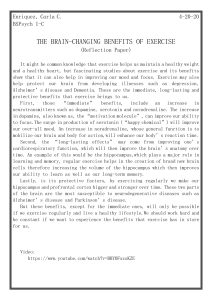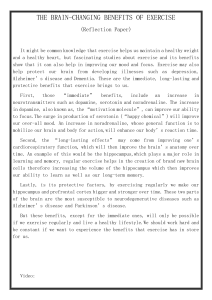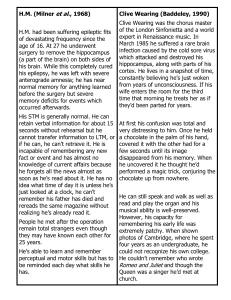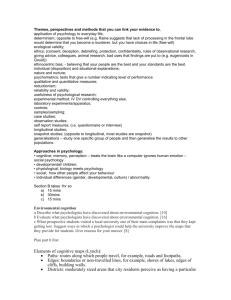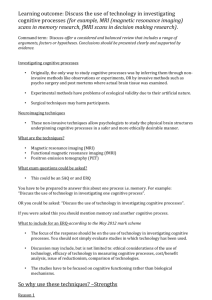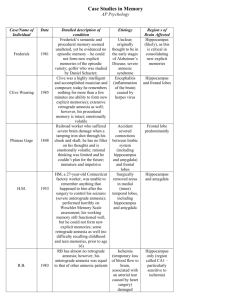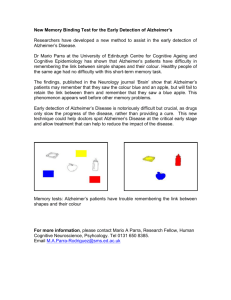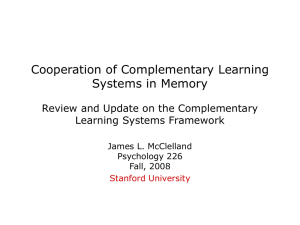Brain and Exercise - Neurogrow
advertisement
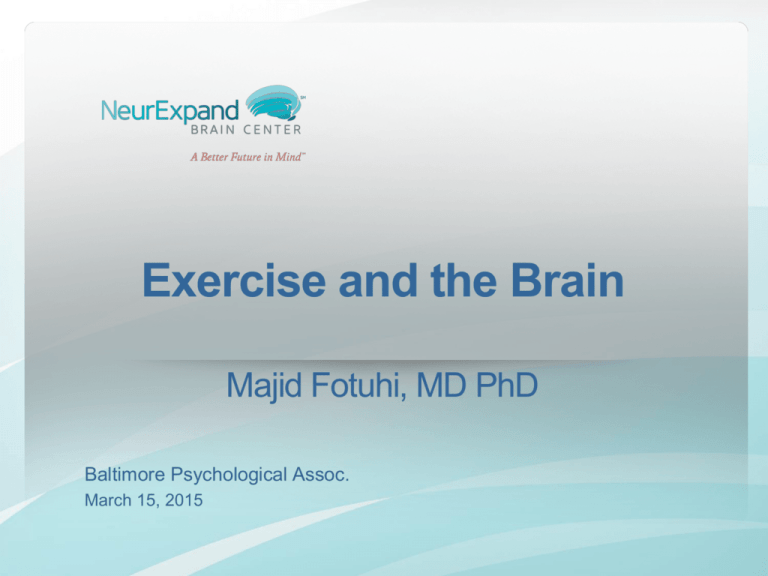
Exercise and the Brain Majid Fotuhi, MD PhD Baltimore Psychological Assoc. March 15, 2015 Objectives What are cognitive functions and brain reserve? How do vascular disease damage the brain? How does exercise boost brain size and function? 2 Cognitive Functions Learning & Memory Language Orientation Calculation Recognizing faces and objects Executive functions Abstract thinking 3 “Cognitive Reserve” 4 Multiple Hits Can Knock Out the Brain Reserve 5 Multiple Risk Factors Each negative risk factor lowers the brain’s threshold to withstand the effects of Alzheimer’s plaques and tangles An elderly person with multiple risk factors is more likely to lose memory at a younger age 6 Multiple Risk Factors Shrink the Hippocampus No Risk Factors Hippocampus 7 Multiple Risk Factors Hippocampus Alzheimer’s vs. Strokes Alzheimer’s disease first causes atrophy in the cortical areas in and around the hippocampus Later, it spreads to other cortical areas Can happen together with small or large strokes Elderly who have both strokes and Alzheimer’s become demented at a younger age 8 Memory Loss & Cognitive Impairment 9 Brain is a Highly Vascular Organ Zlokovic et al. Neurosurgery 43(4), 877–78, 1998 10 Objectives What are cognitive functions and brain reserve? How do vascular disease damage the brain? How does exercise boost brain size and function? 11 Hippocampus Grows Bigger with Walking Three Times a Week Erikson, PNAS 2011 12 Exercise Expands Hippocampus Erickson et al., Hippocampus 19:1030–9, 2009 13 Hippocampus Grows Bigger with Exercise, Even After 3 Months Before After Arch Gen Psychiatry, 2010 14 More Exercise: More Brain Cells 15 Treating Vascular Risk Factors Slows Decline in Dementia Deschaintre et al., Neurology 73:674–80, 2009 16 Deschaintre et al., Neurology 73:674–80, 2009 Walking 1 Mile a Day… Reduces Your Risk of Alzheimer’s ~50% Raji C, et al. Presented at: RSNA 96th Annual Meeting; Chicago, IL: 2010. 17 18 Warm-Up 19 Daily Physical Activity Ask yourself: How much physical activity do your perform each day? 20 Making Small Changes Increasing Steps at Work 1. Go for walk at lunch time and on your breaks. Set a reminder on your calendar 2. Replace a coffee break with a brisk 10 minute walk, don’t want to go alone, ask a co-worker to go with you 3. Take the stairs instead of the elevator, even if you work in a 3 story building you can take the stairs 4. Find a new restroom, copy machine or water fountain on another floor or even the other side of the floor 5. Get off the bus, subway or train earlier than usual and walk the rest of the way home/work 6. Park your car as far away from your company entrance 7. Try a new walking route from work or home to add variety to your daily walk Increasing Steps at Home 8. Wake up half an hour early and go for a walk 9. Stand up an march in place or walk around during commercials 10. Pace every time you have a phone call 11. After dinner, take a walk around the neighborhood. Bring your spouse and/or kids, it’s a great time to reconnect and bond. 12 If you are going to dinner, park far away or leave early and take a longer route to get there 13. Visit and walk local trails, the mall, farmers market or museums. 21 Accountability 10,000 steps per day 22 Exercise ‘Time set aside to condition the body’ Ask yourself: How much exercise do you perform weekly? 23 ACSM Guidelines for Exercise for Healthy Adults Training Component Cardiorespiratory Frequency >5 or >3 or 3-5 Intensity Time (Duration) or Repetitions Type (Activity) Moderate (40% to <60% VO² R/HRR) >30 minutes* Aerobic (cardiovascular endurance) activities and weight bearing exercise 20-25 minutes* Vigorous (>60% VO² R/HRR) 20-30 minutes Combination of moderate and vigorous (40% to <60% VO² R/HRR; or >60% VO² R/HRR) Resistance 2-3 60-80% of 1 RM Or RPE= 5 to 6 (0-10 scale) for older adults 2-4 sets of 8-25 repetitions (e.g., 8-12, 10-15, 1525; depending upon goal) 8-10 exercises that include all major muscle groups (full body or split routine); Muscular strength and endurance, calisthenics, balance, and agility exercise Flexibility >2-3 Stretch to the limits of discomfort within the ROM, to the point of mild tightness without discomfort >4 repetitions per muscle group All major muscle tendon groups Static: 15-60 seconds; PNF: hold 6 seconds, then a 10-30 second assisted stretch Static, PNF, or dynamic (ballistic may be fine for individuals who participate in ballistic activities) 24 Finding Motivation/New Mindset Health Benefits of Exercise: Lowers blood pressure Reduces fatigue Improves mood/decreases depression Improves attention/alertness Lowers risk for heart attack, stroke, and most disease 25 Exercise Prescription 26 In Office Exercises 27 Final Thought 28
